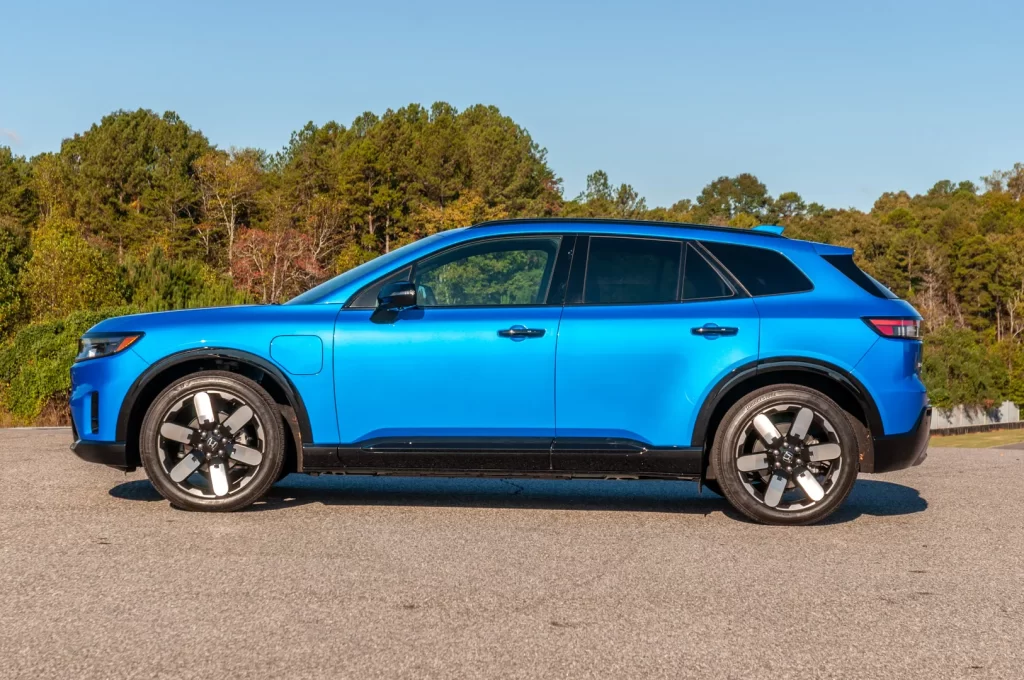
- The Honda Prologue distinguishes itself from the related Chevy Blazer EV with cleaner styling
- Honda’s first mass-produced EV for the U.S. has a range of up to 296 miles
- Starting at $49,000, the Prologue still qualifies for the $7,500 federal EV tax credit
Honda has leaned into its hybrid powertrains on its most popular models in recent years. The CR-V Hybrid and Honda Accord Hybrid account for more than 50% of sales of those models.
Its first electric vehicle, the Honda Prologue, makes a much bigger leap for a brand that has been shy about EVs until this point. That’s one reason why it’s one of five finalists for The Car Connection Best Car To Buy 2025.
The new Honda Prologue is the brand’s first mass-produced electric vehicle for the U.S., following the limited-run Clarity Electric that was discontinued in 2020, and the even-more-limited Fit EV. But it’s not Honda’s alone. Honda partnered with GM to use its architectures and propulsion systems to power the new Prologue—which has the same dimensions and similar interfaces as the Chevrolet Blazer EV, also a finalist for our award.
The wisenheimers out there might say the two crossover SUVs are the same, but the Honda Prologue and Chevy Blazer EV have different personalities befitting their badges. The Prologue top hat is cleaner, simpler, prettier, and more straightforward than the busy work of the Blazer EV’s body. The Prologue has a long low roof, 19- or available 21-inch wheels pushed to the edges, and a solid body-color D-pillar like the larger Honda Passport and Pilot. Honda even spells its name correctly on the tailgate, with an upper-case H and everything. Be still, this scrivener’s heart. The streamlined cleanliness carries over inside, but it’s also where the Honda most appears like a GM, down to the fonts and graphics on the 11.3-inch touchscreen. One big difference? The Prologue comes with Apple CarPlay and Android Auto.
Behind the wheel, the Prologue handles with more stability and less flabbiness, thanks in part to different springs and dampers used by Honda. It’s less high-strung, and tuned more for comfort than sport, especially with its numb steering that doesn’t feel like Honda. It uses an 85.0-kwh battery pack to supply either a single-motor front-wheel-drive setup good for 296 miles of range or a dual-motor all-wheel-drive model estimated at up to 281 miles. In AWD, the two motors make 288 hp and 333 lb-ft of torque, good for a 0-60 mph time in the mid-six-second range.
The Prologue DC fast-charges at up to 150 kw, and can go from 20-80% state of charge in about 35 minutes. At home on a 240-volt AC connection pumping up to 11.5 kw, the Prologue charges to full in about eight hours.
The single-motor Prologue costs about $49,000. Adding a second motor for AWD adds $3,000. The high price is one of our hesitations with naming the Prologue a finalist, especially compared to the smaller, $35,000 Chevy Equinox EV. But, for now, it qualifies for the full $7,500 federal EV tax credit that brings the price below the average transaction price shoppers are paying for new cars of any kind.
The Honda Prologue faces some strong contenders this year, including the smaller, more affordable Equinox EV. Can one of those three meet the EV expectations set by the Kia EV9 electric three-row crossover that won Best Car To Buy 2024? Is it evolutionary enough to unseat the Hyundai Santa Fe Hybrid or another past winner in the Subaru Forester to become Best Car To Buy 2025? We’ll let you know on Jan. 6, 2025, when we also name the performance and green winners on our other websites, Motor Authority and Green Car Reports.


